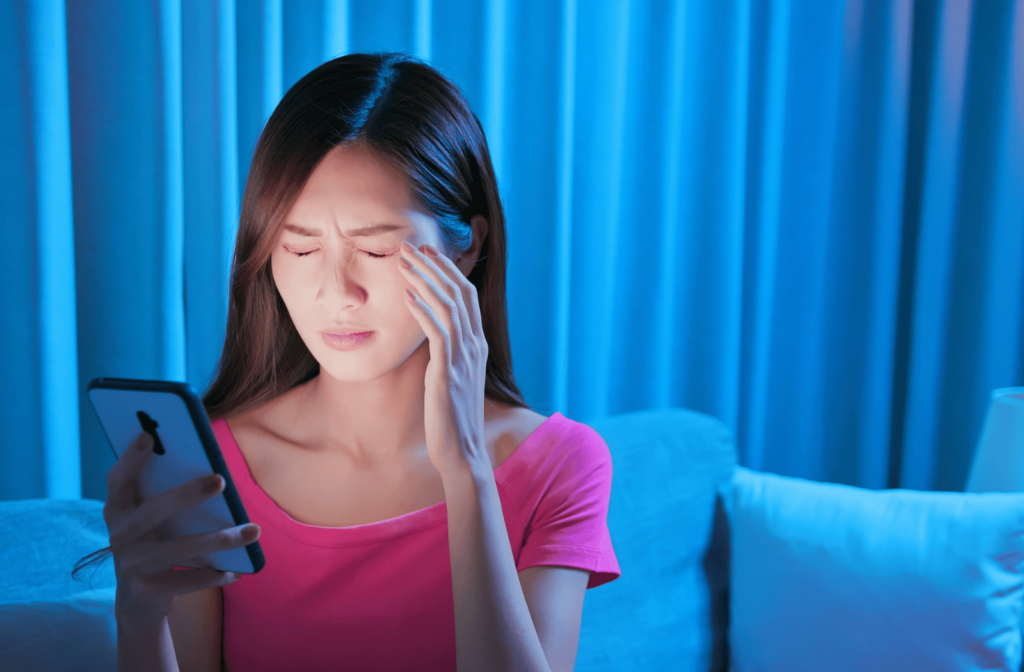We use digital devices for many activities, from reading emails to watching movies. But working, studying, gaming, or shopping with screens for too long can cause digital eye strain.
Digital eye strain is a condition that can cause a cluster of symptoms related to prolonged exposure to digital screens, including eye fatigue, dry eyes, and headaches.
In a digital-centric world, digital eye strain is becoming a greater concern. Fortunately, with awareness, eye exams, and the right eye care precautions, you can diminish the symptoms of digital eye strain and develop healthy screen habits.
What Causes Digital Eye Strain?
Digital eye strain, or computer vision syndrome, is caused by looking at digital screens such as laptops, tablets, televisions, smartphones, or e-readers for extended periods of time. As people spend more time in front of devices, it’s becoming increasingly common, and approximately 50% of computer users have experienced it.
Reading paperwork, writing emails, and looking at text on a screen can be hard on the eyes due to:
- Screen glares
- Poor lighting
- Uncorrected vision problems
- Poor posture during screen use
- Using screens at the wrong distance and angles
- Blinking less
Some also theorize that the blue light from digital screens can contribute to digital eye strain symptoms.
What Is Blue Light?
The light emitted from screens is typically blue light, which has the shortest wavelength with the highest energy of other color wavelengths on the spectrum of visible light.
Because the wavelength of blue light is so close to invisible ultraviolet (UV) rays, there are concerns about the effects it can have on your eyes. However, it is generally believed that blue light from digital screens doesn’t damage our eyes.
However, the blue light emitted from these devices can inhibit melatonin production—the sleep hormone—and disrupt your circadian rhythm. Those effects of blue light can interrupt your natural sleep cycle and keep your body alert when it should be winding down.
Symptoms of Digital Eye Strain
Everyone can experience unique combinations of digital eye strain’s many symptoms, including:
- Eye fatigue
- Dry eyes
- Blurred vision
- Headaches
- Neck and shoulder pain
- Difficulty focusing
- Sensitivity to light
The severity of the symptoms can vary depending on:
- How long you’ve been using your device
- Whether you’re wearing the correct prescription lenses
- Other underlying eye problems
If you’re experiencing these symptoms and spend your work day and leisure time using screens, you may benefit from contacting your optometrist for an eye exam.
How Do You Prevent Digital Eye Strain?
It’s not easy to avoid screens altogether because many people rely heavily on digital devices for work and communication, but there are several measures you can take to prevent digital eye strain.
Take Regular Screen Breaks
Giving your eyes a break helps reduce eye strain. Use the 20-20-20 rule—look away from your screen at an object 20 feet away for 20 seconds every 20 minutes.
Adjust Your Screen Brightness
Increase your screen’s brightness level to match the ambient light, and avoid using digital devices in low-light conditions. As lighting conditions change, you can adjust the warm and cool contrast throughout the day to find a setting that provides relief.
You can also experiment with dark mode settings on websites and mobile apps to determine if they provide any relief for your eyes.
Avoid Glare
A common complaint among screen users in brightly lit areas is glare. Anti-glare screen protectors offer a filter to eliminate glare and reflection that can worsen eye strain. You can also get anti-glare coatings for prescription glasses.
Reposition Your Computer Screen & Chair
The ergonomics of your screen setup can alleviate or worsen your digital eye strain, shoulder aches, and neck pain. For proper ergonomics, your computer screen should be at arm’s length from your eyes and slightly below eye level.
Your chair should be adjusted to a height that allows your feet to be flat on the floor, and your keyboard should be close to your body.
Consider New Glasses
Some computer glasses are designed to reduce symptoms associated with prolonged computer use by providing a focusing power that can be easier on the eyes when working from a certain distance. Computer glasses may also be designed to filter out blue light.
Symptoms of eye strain may also be related to refractive errors like myopia and presbyopia making it harder for your eyes to focus in front of a screen. In that case, you may need new prescription lenses or an updated prescription.
In either case, a visit with your eye doctor can help you determine which types of glasses and lenses may be helpful for reducing the symptoms of eye strain.
How Can You Manage Digital Eye Strain?
If you’re experiencing digital eye strain symptoms, there are a few things you can do to ease the discomfort, including the following:
- Try to blink enough to help your eyes stay lubricated
- Adjust the brightness, color temperature, and contrast level of your screen to make it more comfortable for your eyes
- Increase the text size on your computer
- Use eye drops or artificial tears to keep your eyes moist
- Take frequent breaks to stretch your arms, neck, and back and relax your muscles.
You Can Use Digital Devices Comfortably
Digital eye strain might be a side-effect of your busy digital life, but you don’t have to live and work in discomfort. Comprehensive eye exams are crucial for healthy screen use, and wearing the right prescription can make a significant difference.
Schedule an eye exam at Daniel Island Eye Care to assess your vision, update your prescription, and find the frames and lenses that support healthy vision during work and play.





